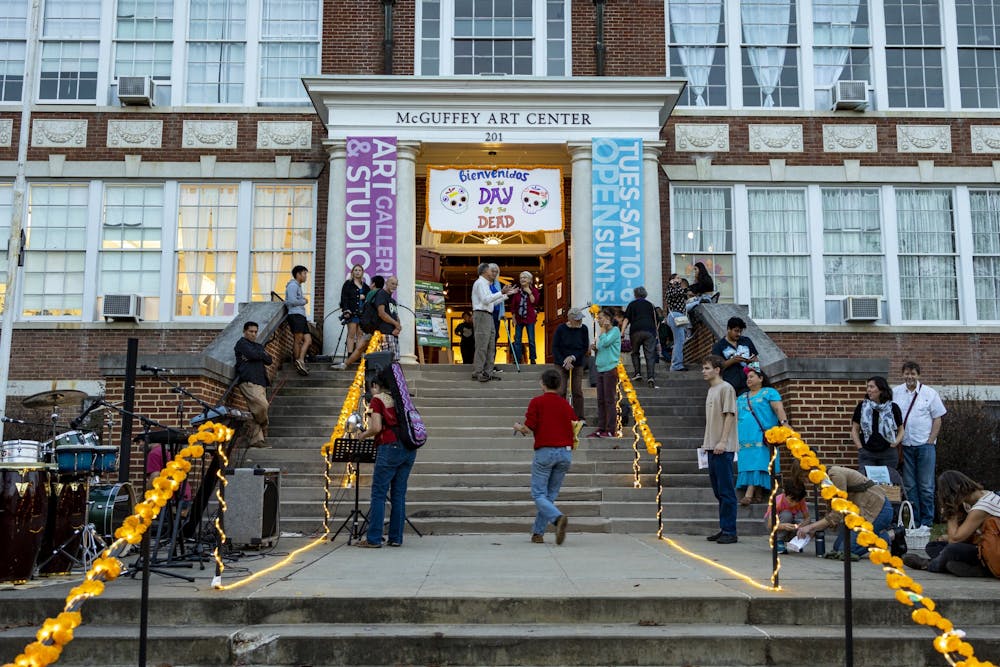Traditionally observed Nov. 2 of each year, Día de los Muertos is a joyful holiday that celebrates the lives of the deceased and signifies the reunion of the dead and their living loved ones for a day. Last weekend, Charlottesville residents and students alike gathered for the 11th annual Día de los Muertos Celebration at the McGuffey Art Center from 4:30 p.m. to 8 p.m. Saturday evening.
Hosted in conjunction with Lua Project, Sin Barreras, The Bridge Progressive Arts Initiative and the McGuffey Art Center, the Día de los Muertos Charlottesville Celebration showcased a number of talented artists and allowed families to celebrate the holiday together through craft-making and games.
People gathered on the front lawn of the McGuffey Art Center to order from local food truck Taqueria Chaparro and to listen to the Lua Project’s signature Mexilachian music, a blend of traditional music from Mexico, Appalachia and the Atlantic Basin.
Cultural organizer and musician Estela Diaz Knott was first inspired to start the annual celebration while teaching a music class to young children at the McGuffey Art Center.
“The majority of the people that I was doing these classes with were from Mexico, and from various states and Mexico like Puebla and Veracruz,” Knott said. “So when they were talking about the different celebrations, Day of the Dead came up and they just all lit up.”
The first Día de Los Muertos Charlottesville Celebration was held in 2011. After seeing the exceptionally large turnout for the event, Knott and her fellow organizers were so moved that they decided to host it annually.
Today, the Día de los Muertos celebration is very much a community effort. Every year, volunteers from throughout Charlottesville help build and decorate the Ofrenda, an altar constructed to allow for the souls of the deceased to enjoy earthly pleasures again during the holiday.
Fourth-year College student Mary-Dryden Maio volunteered at the event this year after Knott came to speak in her class “Moving On: Migration In/To the U.S.,” which is offered through the University’s English and American Studies departments. Maio helped with the general setup of the event and decorating the Ofrenda.
During the celebration, participants were able to make luminarias.
“They’re these little white bags that you put a candle in and you write a message to someone who has died, and put it on the altar,” Maio said.
Participants at the event were encouraged to place their luminarias on the Ofrenda to help celebrate the lives of the deceased. Additionally, rows of candles, greenery, photos of loved ones, sugar skulls and flowers adorned the altar as well.
Elsewhere at the event, a table displayed traditional masks made by Mexico-based artist Rafael Jemenez-Lopez from Puebla. The masks were later used for the Danza Tecuanez performance, a traditional dance from Puebla depicting a jaguar attacking two tribes. Dancers in colorful garb donned the masks and moved around a jaguar to drums and energetic flute music, while the jaguar snapped a rope whip.
People continued to mill around, chatting with one another and enjoying the music as the sun started to set. During a break in performances, Brenci Papino, professor of Spanish at Mary Baldwin University, provided context about Dia de los Muertos to event-goers by explaining its origins.
“[Dia de los Muertos] is rooted in pre-Columbian traditions, religion, and also the philosophy or the fact that life and death were not really separate, but they’re part of one single cycle,” Papino said. “And so, when Catholicism arrives, there are elements of cultural syncretism. There are elements of Catholicism that were quickly absorbed into these celebrations.”
As the night wound down, Charlottesville-based Villa Sabrosa dance troupe performed two dances to traditional Mexican music. Finally, local group Poder Supremo closed out the night with a performance from 6:30 to 8 p.m., as people danced along to the upbeat, festive music.
Second-year Architecture student Bryan Lopez came to the event after hearing about it through a GroupMe chat meant for Latinx students in the Charlottesville community. Lopez said his family has not traditionally celebrated Dia de los Muertos, but he recently became more involved. Excited by the diversity in age between the participants, Lopez said he appreciated the community-building potential of the celebration most.
“In urban planning, something we talk about is how communities begin to become disconnected, and that leaves multiple people, at least certain members of our community, vulnerable, especially the elders,” Lopez said. “Earlier, I saw this couple of grandparents with their young grandchild running up and down the hallway, and those are really clear bonding moments for both parties.”
Beyond the Día de los Muertos event, Knott continues to plan further cultural events for the Charlottesville community, including a bilingual dance class and bilingual open mic and hopes to receive more support from the city going forward. Her cultural aspirations for the Charlottesville community, though, reach much higher.
“I would love to have a cultural center,” Knott said. “That is something that I would love to be able to do at some point, where we can just share our cultures.”







